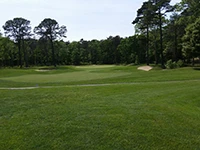
Zac Reicher, Ph.D., is part of the Bayer Green Solutions Team.
Many diseases cause problems in creeping bentgrass/annual bluegrass greens as temperatures rise in May and June. Two of the most problematic are dollar spot and anthracnose.
Dollar spot
Dollar spot is favored by air temperatures ranging from 60-90 F, with extended periods of high humidity. Increasing air movement with tree removal or fans and minimizing leaf wetness with early morning mowing, rolling, or polling can help reduce dollar spot. Dollar spot is favored under low nitrogen, so light frequent applications of nitrogen can help maintain turf growth and minimize infection. Dollar spot is most problematic on slow-growing turf, which are the same conditions favoring fast green speeds. Thus fungicides are usually relied on to manage dollar spot in golf greens.
Though symptoms of dollar spot usually become visible in early summer, a fungicide application in early spring can reduce inoculum and delay the onset of dollar spot symptoms. Though too late for this season, DMI fungicides like Bayleton FLO, Tartan and Mirage StressGard timed for fairy ring (average soil temperatures of 55 NF at a 2-4-inch depth) can delay dollar spot symptoms for 8-12 weeks. Fungicides will be needed throughout the summer when temperatures are 70-90 F, and should be stretched into the fall for extended dollar spot control. Interface StressGard and 26GT are helpful in hot weather since they are non-DMIs and can be used without risk of negative plant growth effects. A last application when temperatures cool in the fall will help clean-up remaining dollar spot and prevent late-season outbreaks.
Some golf courses may have dollar spot resistant to some fungicides. Preventive applications when inoculum is low, rotating fungicide classes, and using multi-site fungicides are important for reducing the risk and impact of resistance. Bayleton FLO, Tartan or Mirage StressGard control benzimidazole-resistant dollar spot whereas Interface StressGard and 26GT are effective against DMI-resistant populations.
Anthracnose
Anthracnose can be a foliar blight and/or a basal rot primarily on annual bluegrass greens, but also creeping bentgrass greens under stress when turfgrass growth is slow. Anthracnose is most common in mid-summer under hot conditions, or in fall through spring under cold, wet conditions. Foliar blight develops on older leaves first and is most common in the summer. Basal rot anthracnose can develop from foliar blighting, or independently during periods of cold, wet weather or summer wilt stress. Since anthracnose usually occurs when turf growth is slow, recovery is difficult and preventative cultural and fungicidal controls are most effective.
Rutgers University has led the research on cultural controls of anthracnose. Effective cultural controls include spoon-feeding nitrogen on a 7-to-14-day basis, keeping potassium at moderate soil levels, and maintaining mowing heights > 0.125 inches with rolling or double mowing to maintain speeds. Light and frequent sand topdressing will also reduce anthracnose, but limit topdressing rates so it can be watered in or brushed in easily to limit stress. Since anthracnose is most prevalent when turf is under stress, irrigate at 60-80 percent base ET to prevent moisture stress to already shallow-rooted turfs. Controlling annual bluegrass seedheads in the spring with Proxy should also help reduce summer stress and limit anthracnose.
Fungicides for anthracnose should begin when average soil temperatures at the 2-4-inch depth are 65-68 F, well before the onset of summer stress. Fungicide resistance can be problematic with anthracnose. QoI and benzimidazole fungicides may not provide adequate control due to resistance, but other fungicide classes remain effective for anthracnose control. Mirage StressGard and Chipco Signature+Daconil Ultrex are excellent solutions for anthracnose control. Be sure to follow label instructions for all pesticides, particularly directions for resistance management when applying fungicides for anthracnose.
Latest from Golf Course Industry
- Heritage Golf Group acquires North Carolina courses
- Editor’s notebook: Green Start Academy 2024
- USGA focuses on inclusion, sustainability in 2024
- Greens with Envy 65: Carolina on our mind
- Five Iron Golf expands into Minnesota
- Global sports group 54 invests in Turfgrass
- Hawaii's Mauna Kea Golf Course announces reopening
- Georgia GCSA honors superintendent of the year





